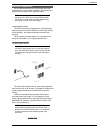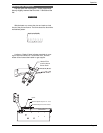
Installation
Page 8
Figure 7. Vent Piping Requirements.
The weight of the vent stack or chimney must not rest on
heater drafthood. Support must be provided in compliance
with applicable codes. The heater top and drafthood must be
readily removable for maintenance and inspection. Vent pipe
should be adequately supported to maintain proper clear-
ances from combustible construction.
Type "B" double-wall or equivalent vent pipe is recom-
mended. However single-wall metal vent pipe may be used
as specified in the latest edition of the National Flue Gas
Code ANSI Z223.1 (Canada - CAN/CGA-B149.1 and
B149.2).
GAS CONNECTIONS
Gas piping must have a sediment trap ahead of the
heater gas controls, and a manual shut-off valve located out-
side the heater jacket. All gas piping should be tested after
installation in accordance with local codes.
Figure 8. Gas Line Sediment Trap.
(field supplied)
(field supplied)
(field supplied)
CAUTION
THE HEATER AND ITS MANUAL SHUT-OFF VALVE MUST
BE DISCONNECTED FROM THE GAS SUPPLY DURING
ANY PRESSURE TESTING OF THAT SYSTEM AT TEST
PRESSURES IN EXCESS OF 1/2 PSIG (3.5 KPA). THE
HEATER AND ITS GAS CONNECTIONS SHALL BE LEAK
TESTED BEFORE PLACING THE APPLIANCE IN OPERA-
TION. USE SOAPY WATER FOR LEAK TEST. DO NOT
USE OPEN FLAME.
NOTE: Do not use Teflon tape on gas line pipe
thread. A flexible pipe sealant suitable for LP gases
is recommended.
GAS PRESSURE REGULATOR
If adjustment is needed, remove seal and turn adjustment
screw clockwise to increase pressure or counterclockwise to
decrease pressure.
Table 4. Gas Pressure.
*Static means without heater operating. Dynamic refers to heater operating.
GAS PRESSURE ADJUSTMENT LOCATIONS
Figure 9A. Honeywell DSI VR 8205 Gas Valve.
Figure 9B.
Robertshaw MV Gas Valve.
Gas Pressure Adjustment
B.
Gas Pressure Adjustment
A.
Gas Pressure* Natural Gas Propane Gas
Max Inlet (static) 10.5" W.C. 13" W.C.
Min Inlet (dynamic) 7" W.C. 11" W.C.
Manifold Gas (dynamic) 3.5" W.C. 10" W.C.


















